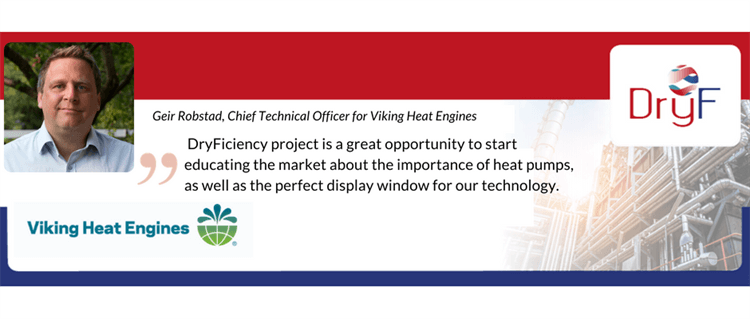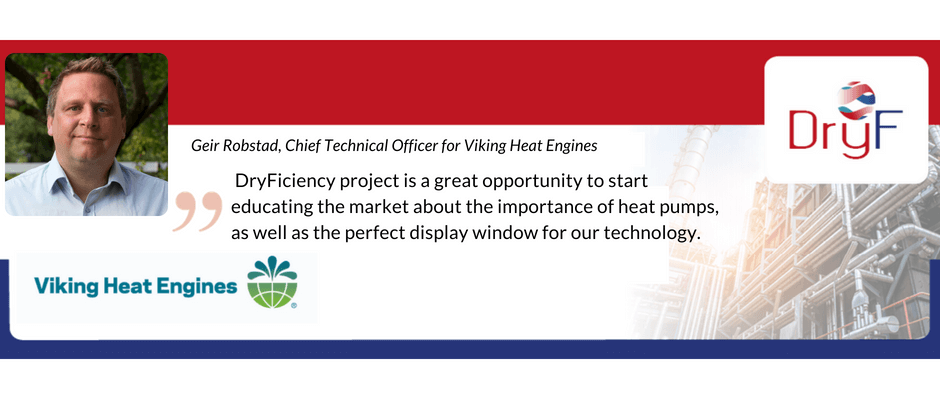

1. Can you introduce yourself please: what is your name and position/function in the company?
My name is Geir Robstad, Chief Technical Officer at Viking Heat Engines in Norway and the company’s Project Manager relating to AIT’s heat pump projects, including the DryFiciency project. I am also responsible for the heat-to-power market, with a special focus on marine and power plant applications.
Viking Heat Engines develops industrial heat pumps, compressors and ORC heat engines. Our company started back in 2009 with the ORC heat engine, the CraftEngine. In the process of developing this engine, which took us six years, we established a close collaboration with Chemours (a former performance chemical division of DuPont). Chemours made us aware that our current ORC heat engine was very close to the technology of heat pumps; it is basically a heat pump in reverse! As a result, we started running tests to check the compatibility one and a half years ago, and we did so without changing any of the core components of the heat engine. Our ORC expander was already designed to work with temperature up to 215°C and the positive test results led us to create our own industrial heat pump.
2. What is your motivation to participate in the DryF project and develop new components for increasing energy efficiency in industry?
The vision of Viking Heat Engines is to accelerate the world’s energy transition towards a sustainable future. We’re part of what we in Norway call “the green shift”, which is the transition to renewable energy. The world needs to drastically reduce its dependence on fossil fuels and become much better at utilizing the energy it already produces to meet the goals outlined in the Paris Agreement. We know these might be worn out words, but we want to be part of this change; something drastic needs to be done and we have the technology needed to make a difference.
We were very happy to join the project, especially since there’s a lot of groundbreaking work/research being done within the consortium and it gives us a perfect chance to demonstrate our technology at a customer site of a large international company.
Furthermore, the consortium consists of highly skilled personnel from strong companies, which gives us an opportunity to establish new relationships and hopefully meet future partners from the sector. Lastly, the DryFiciency project is a great opportunity to start educating the market about the importance of heat pumps, as well as the perfect display window for our technology.
3. How important is the large/industrial heat pump market for you?
The large/industrial heat pump market is very important for us and we consider it to be our main market in the future. Today our main products are the ORC heat engine and the industrial heat pump/compressor, but we believe that the industrial heat pump market will be much larger than the ORC heat-to-power market, and will probably generate the biggest part of the company’s revenue.
4. What is the role of sustainability in your product development?
I believe our vision says what kind of sustainability profile we want to have. Up until now, our focus has primarily been on using environmentally friendly refrigerants with a low global warming potential, but once we have a large-scale serial production in place we will make sure to take a more holistic approach to how we run our business and produce our products. We are currently in dialogue with production partners for large-scale serial production and in that process, we will have sustainability high on our agenda.
Project Coordinator
Veronika Wilk
AIT Austrian Institute of Technology GmbH


| Cookie | Duration | Description |
|---|---|---|
| cookielawinfo-checkbox-analytics | 1 year | This cookies is set by GDPR Cookie Consent WordPress Plugin. The cookie is used to remember the user consent for the cookies under the category "Analytics". |
| cookielawinfo-checkbox-necessary | 1 year | This cookie is set by GDPR Cookie Consent plugin. The cookies is used to store the user consent for the cookies in the category "Necessary". |
| cookielawinfo-checkbox-others | 1 year | This cookie is set by GDPR Cookie Consent plugin. The cookie is used to store the user consent for the cookies in the category "Others". |
| cookielawinfo-checkbox-performance | 1 year | This cookie is set by GDPR Cookie Consent plugin. The cookie is used to store the user consent for the cookies in the category "Performance". |
| viewed_cookie_policy | 1 year | The cookie is set by the GDPR Cookie Consent plugin and is used to store whether or not user has consented to the use of cookies. It does not store any personal data. |
| Cookie | Duration | Description |
|---|---|---|
| CONSENT | 16 years 4 months 8 days 15 hours 5 minutes | These cookies are set via embedded youtube-videos. They register anonymous statistical data on for example how many times the video is displayed and what settings are used for playback.No sensitive data is collected unless you log in to your google account, in that case your choices are linked with your account, for example if you click “like” on a video. |
| IDE | 1 year 24 days | Used by Google DoubleClick and stores information about how the user uses the website and any other advertisement before visiting the website. This is used to present users with ads that are relevant to them according to the user profile. |
| VISITOR_INFO1_LIVE | 5 months 27 days | This cookie is set by Youtube. Used to track the information of the embedded YouTube videos on a website. |
| YSC | session | This cookies is set by Youtube and is used to track the views of embedded videos. |
| yt-remote-connected-devices | never | These cookies are set via embedded youtube-videos. |
| yt-remote-device-id | never | These cookies are set via embedded youtube-videos. |